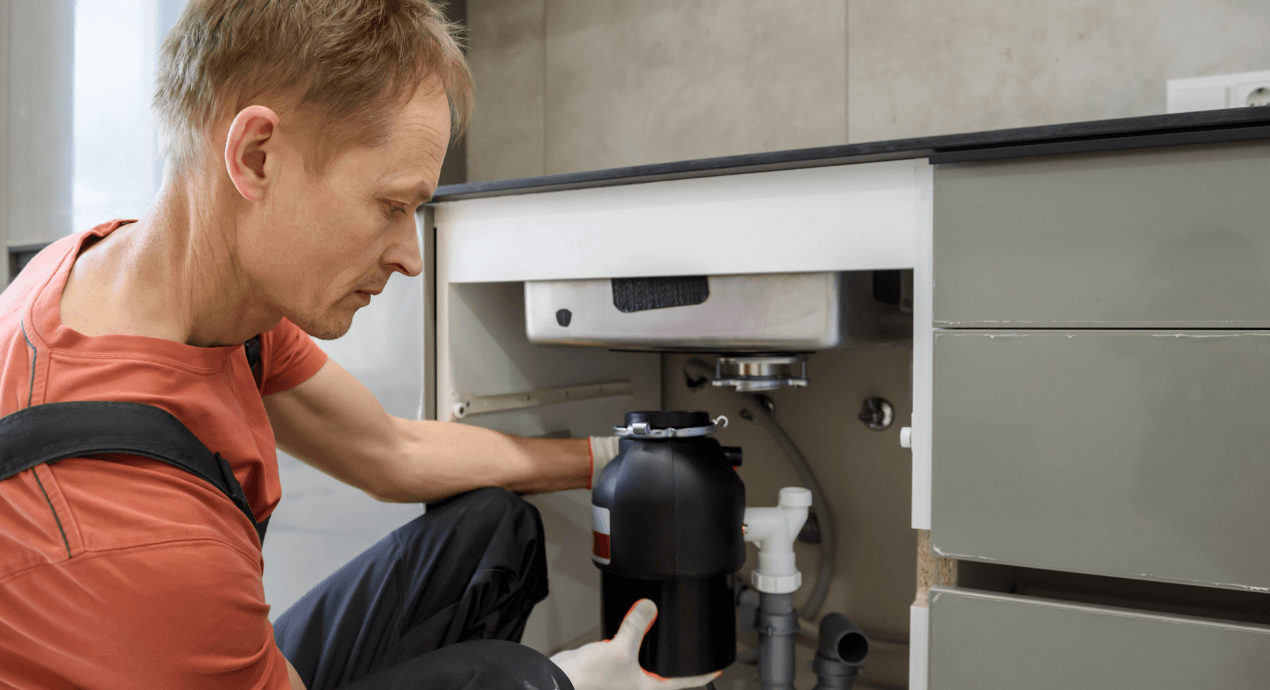
Contemplating coverage?
Subscribe to receive our emails & get
$200 OFF!
Have questions?
Call us: (833) 544-8273


Written By Allaire Conte
A garbage disposal is one of those kitchen appliances you don’t think much about — until it starts leaking. If you’ve noticed water pooling under your sink, chances are your garbage disposal is leaking from the bottom, and that’s a problem you don’t want to ignore.
The good news? You can often diagnose and fix it yourself without calling a plumber. Let’s go over the common causes, how to find the source of the leak, and what you can do to fix it.
There's a reason Liberty Home Guard was rated the #1 Home Warranty
Service by U.S. News and World Report for 2021, 2022, 2023, and 2024. Check out our services.
Leaks are most often caused by overuse or corrosion, but there are a lot of components that are vulnerable to these effects. Here’s where to look first:
Garbage disposals contain internal seals that keep water from leaking out. Over time, these seals can wear down due to constant exposure to water, food particles, and pressure. If your garbage disposal is leaking water from the bottom, chances are the internal seals have given out. This is especially common in older units that have been running for years.
If your rusted garbage disposal is leaking, you may be dealing with cracks in the internal components or the outer casing. Rust and corrosion happen naturally over time, especially if your disposal has been exposed to excessive moisture or hasn’t been maintained properly. Once cracks form, leaks are inevitable.
Your garbage disposal is connected to your home’s plumbing via a discharge pipe. If that pipe becomes loose or damaged, it can lead to leaks. Sometimes, it’s just a matter of tightening the connection, but in other cases, the gasket, pipe, or garbage disposal may need replacing.
The sink flange is what connects the disposal to the sink, and it’s sealed with a rubber gasket and plumber’s putty. Over time, these seals can weaken, leading to leaks. If your garbage disposal is leaking but you’re not sure from where, this is one of the first places to check.
If you’re constantly using your disposal to grind up heavy food scraps, it can put strain on the unit. A clogged or slow-draining disposal can cause water to back up, which might make it seem like it’s leaking when the real problem is a blockage further down the line.
If you want to repair your garbage disposal, the first step is to figure out what’s wrong. As with fixing any appliance, it’s important to follow protocol to stay safe and on task.
Safety first! Before touching your garbage disposal, make sure to turn off the power at the circuit breaker. This ensures you won’t accidentally turn it on while inspecting for leaks, which can be extremely dangerous.
Use a towel to dry the entire disposal. Once it’s dry, run a small amount of water through the sink. Keep a flashlight handy and watch closely for any signs of dripping. If the leak is slow, you may need to wait a few minutes for water to start pooling beneath the unit. Place a dry paper towel or piece of cardboard underneath to help detect smaller leaks.
If water is dripping from the very bottom of the disposal, the problem is most likely due to worn-out internal seals or cracks in the casing. Unfortunately, these issues are not easily repairable, and a full replacement may be necessary. If the leak is small, you might be able to temporarily manage it with a sealant, but this is usually a short-term fix.
If the leak appears to be coming from the side of the disposal, check the discharge pipe and sink flange for loose fittings or deteriorated seals. Sometimes, simply tightening a connection can stop the leak. If the leak persists, you may need to replace a worn-out gasket or reapply plumber’s putty to the sink flange to create a watertight seal.
With so many possible causes of a garbage disposal leak, it’s best to break the repair process down based on where the leak is coming from. A leak from the bottom typically means internal components have failed, while a leak from the side or top could be due to loose plumbing connections or a worn-out sink flange.
Most home warranty plans cover garbage disposals, but coverage can vary. If your disposal breaks down due to normal wear and tear, a home warranty will typically cover the cost of repairs or replacement. However, damage from improper use, lack of maintenance, or pre-existing issues may not be included. Check your specific policy to understand what’s covered and any service fee you might need to pay for a repair.
If your garbage disposal is leaking from the bottom due to age, rust, or seal failure, replacing it is often the best option. Most disposals last between 8-15 years, so if yours is approaching that range, it might be time for an upgrade. Newer models are often more efficient and quieter, making replacement a worthwhile investment.
Replacing a garbage disposal typically takes 1-2 hours for someone with basic DIY skills. However, if new plumbing or electrical adjustments are needed, the process may take longer.
It's not recommended to use a garbage disposal that is leaking from the bottom, as it could cause further water damage or electrical hazards. Turn off the power and address the leak immediately.
Regular maintenance, such as cleaning the unit, avoiding hard or fibrous foods, and checking for loose connections, can help prolong your garbage disposal’s lifespan and prevent leaks.
Stay Ahead of Potential
Home Mishaps!
Subscribe to our Liberty Home Guard Newsletter and gain access to exclusive content that ensures your peace of mind.